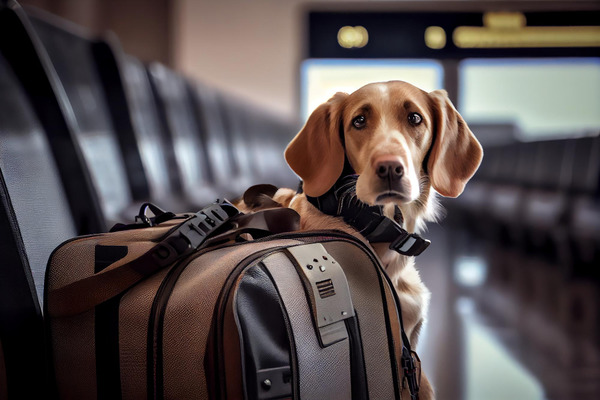(3)
Spend more to get free priority shipping
Great. You will get complimentary priority shipping for free.
Previous registration has been removed from the cart as only one animal registration is allowed at a one time.
Please note that there is no unified Assistant Animal database registration in the USA.
You cannot verify information from other registrars on the ESACERT.com website
Traveling with a service animal can be a daunting process, especially when flying. Service animals, such as service dogs, are crucial companions for individuals with physical or mental impairments, assisting in performing specific tasks. However, navigating the legal and logistical aspects of air travel with a service animal is essential to ensure ...


Traveling with a service animal can be a daunting process, especially when flying. Service animals, such as service dogs, are crucial companions for individuals with physical or mental impairments, assisting in performing specific tasks. However, navigating the legal and logistical aspects of air travel with a service animal is essential to ensure a smooth experience.
This article will provide valuable information on how to fly with a service animal legally, addressing essential legal requirements, necessary documentation, and tips for service animal users.
According to the Department of Transportation (DOT), a service animal is typically defined as a dog that is individually trained to perform tasks directly related to an individual’s disability. While emotional support animals (ESAs) once had similar travel rights, they are no longer recognized as service animals by most airlines.
When flying with a service animal, airlines require the DOT’s Transport Form to be completed before boarding. This form certifies that the service animal is necessary to aid a person with a disability. Airlines may also ask for a vet’s contact information, ensuring the service dog is in good health and up to date on vaccinations.
Airlines are required to accommodate service dogs, but passengers must submit appropriate documentation, such as the DOT transportation form. You may also be asked to provide proof that your dog is a qualified individual and trained for specific tasks to assist with disabilities.
Before flying with a service animal, it’s crucial to inform the airline in advance, typically 48 hours before your flight. This helps the airline accommodate both the service animal and other passengers, ensuring the service animal fit within the handler’s foot space without causing a significant disruption.
Airlines have specific size requirements for service animals traveling in the cabin. If your service dog is small enough, it can sit in your foot space. However, if you have a larger service dog, airlines may ask for an empty seat next to you. If your service dog is too large to fit comfortably, the airline may not permit it in the cabin and could require the dog to be transported in the cargo hold free of charge.
To get through TSA with a service dog, you and your dog must go through security screening together. The dog will be visually and physically inspected by the TSA agent, who checks for physical indicators that the animal is trained to perform tasks related to your disability. Make sure your dog is well-behaved and familiar with potentially stressful environments like a long security line and a crowded airplane cabin.
Your service dog will usually be seated in your foot space. If you require extra room, such as an empty seat next to you, make these requests when booking your flight. Service dogs must behave properly throughout the flight, staying quiet and unobtrusive to other passengers.
One concern many service dog owners have is what to do if their dog needs to relieve itself during the flight. Airlines typically designate service animal relief areas at the airport, but you should train your dog to go long periods without needing a break or use pads in case the dog has to pee in-flight.
When traveling internationally, verify the destination country’s requirements for service animals. Some countries have quarantine laws or require specific documentation, such as proof of vaccination. It’s essential to consult the airline’s policy and the regulations of the destination country.
Airlines typically require passengers to submit the DOT’s Transport Form, which verifies that the service dog is trained and necessary for the passenger’s disability. Additionally, the airline may request a vet’s contact information and proof of vaccinations to ensure the service dog’s health is up to date.
Airlines are strict in ensuring that only genuine service animals are permitted in the cabin. They may require documentation and behavioral evaluations of the animal to ensure it does not pose a direct threat or cause significant disruption. Service dogs must behave properly throughout the journey.
Yes, service animals are allowed to go through TSA security with their handlers. TSA agents will inspect the dog for physical indicators that it is a service animal, but the process is designed to be quick and non-intrusive. The service animal must remain on a leash during security screening.
Your current registration:
After change, your registration will be:
Your current registration:
will be replaced with:
You have entered the maximum number of characters
You have entered the maximum number of characters
You have entered the maximum number of characters
You have entered the maximum number of characters
You have entered the maximum number of characters
EC-0000001
Oct 26, 2025
-
-
-
-
-
-
You have entered the maximum number of characters
You have entered the maximum number of characters
You have entered the maximum number of characters
You have entered the maximum number of characters
You have entered the maximum number of characters
You have entered the maximum number of characters
You have entered the maximum number of characters
Enter at least 3 characters to search. You have entered: